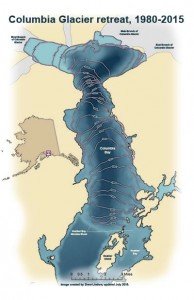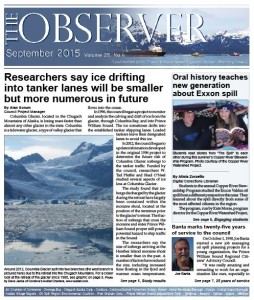By Alan Sorum
Council Project Manager

Columbia Glacier, located in the Chugach Mountains of Alaska, is losing mass faster than almost any other glacier in the state. Columbia is a tidewater glacier, a type of valley glacier that flows into the ocean.
In 1996, the council began a project to monitor and analyze the calving and drift of ice from the glacier, through Columbia Bay, and into Prince William Sound. The ice sometimes drifts into the established tanker shipping lanes. Loaded tankers leave their designated lanes to avoid this ice.
In 2012, the council began to update information developed in the original 1996 project to determine the future risk of Columbia Glacier icebergs to the tanker traffic. Funded by the council, researchers W. Tad Pfeffer and Shad O’Neel studied several aspects of ice loss at Columbia Glacier.
The study found that icebergs discharged by the glacier during the retreat have largely been contained within the moraine shoal, located at the position of the terminus prior to the glacier’s retreat. The fraction of icebergs that cross the moraine and enter Prince William Sound proper still pose a potential hazard to ship traffic in the Sound.
The researchers say the size of icebergs arriving at the Heather Island moraine shoal is smaller than in the past. A number of factors have reduced the size, including increased time floating in the fjord and warmer ocean temperatures. This means that, in the future, a larger fraction of icebergs may be able to escape over the moraine.
However, their study of the sea floor at the moraine shoal indicates that the shoal has not eroded over the course of the retreat. The researchers are confident that the shoal will continue to block the passage of large icebergs out of the fjord and into Columbia Bay. Whether the smaller but more numerous icebergs will increase or decrease the risk to the safe transportation of oil through Prince William Sound depends in part on what size classes of icebergs are viewed as posing the greatest hazard to ship traffic moving in and out of Port Valdez.

Facts about Columbia Glacier:
Columbia Glacier has retreated more than 10.5 miles and lost 50 percent of its volume, mostly due to calving, since the early 1980s.
The ice lost is estimated to be equivalent to 28 to 36 cubic miles of water (1 cubic mile of water would cover the nearly 7000 square miles of Prince William Sound by one foot deep).
Researchers predict the retreat of the Columbia Glacier will cease by 2029 – 2036.
Future icebergs will be smaller but more numerous.
The maximum calving rate during the remainder of the retreat is estimated to range from 5.8 to 6.2 cubic kilometers, or 3.6-3.8 cubic miles, per year.
More episodes of increased calving are expected, with one episode imminent.
Read the report:
To read the entire series of reports and a detailed description of the findings, visit our information page on Columbia Glacier.